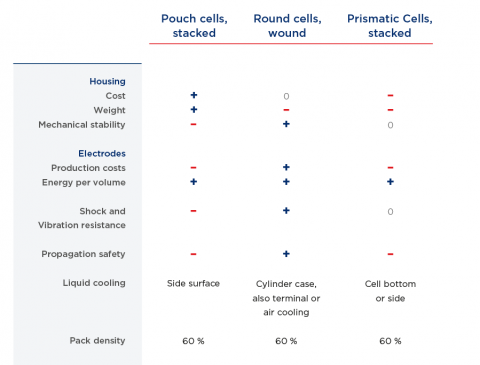
Lithium-ion cells come in three designs: cylindrical, prismatic or pouch-shaped. Cylindrical cells are also called round or wound cells, prismatic cells have a rectangular format. The different designs have different properties. Which cell design is best depends on the requirements of the intended application.
Cylindrical cell design is recommended for all applications that require robust, vibration- and shock-resistant battery cells that can withstand mechanical stress as well as elevated internal pressure and are inexpensive to manufacture. Space applications, for example, necessarily require large-format round cells. But also in the maritime industry or the automotive, NRMM and aviation segments, the mechanically stable cells could literally take on carrying functions in vehicle or aircraft construction. Especially in combination with the cell chemistry lithium iron phosphate, the cylindrical cell design offers the highest possible safety for people moving on water, in the air, under the earth or in space.
The battery layout and the number of units form further factors in the decision for or against a cell design. The quality in the production of round cells is high; they can be manufactured quickly, efficiently and with repeatable accuracy. The electrode foils are wound by machine from a roll onto a mandrel. The winding machines work extremely accurately and at high speed. The basic principle of cell winding is thus simple - in contrast to the production of stacked pouch or prismatic cells. They require only a few process steps and generate hardly any waste. Therefore, large-format wound cells can be produced much more cost-effectively.
Pouch cells have the advantage that the pressure and surface load of the electrodes are balanced. However, pouch cells require the use of a frame, as they are not mechanically resilient, which directly eliminates their particular cost advantages due to the savings in volume and housing.
The housing of cylindrical cells is suitable for all common cell chemistries, which is another unique selling point of the cylindrical cell design. Compared to pouch cells, the housing is relatively heavy, but stable. In particular, strongly gassing (manganese-rich) cell chemistries require such an internal pressure-resistant housing. In addition, the stable housing of cylindrical cells contributes to their pronounced shock and vibration resistance as well as their carrying capacity within a mechanical construction.
In the battery pack, the round cells are connected stably and securely, if desired also by means of a screw. The pack itself is propagation-proof. This means that the thermal effect of a single cell does not have a domino effect on the entire pack. Jackets and poles are open and the air can flow around them easily and cool them. But jacket cooling with cooling hoses between the cells is also possible, as is pole cooling.
EAS has been developing and producing large-format round cells for 25 years for a solid and steadily growing customer base. In the meantime, major automotive manufacturers also entrust EAS with the development of their new cells - due to the high and consistent quality of the existing EAS cell portfolio. LFP and high-power cells in particular are among EAS's core competencies.
The fact that the cylindrical cell design will continue to prevail in the future is already shown because of fact that, in addition to some research approaches to new cell designs, it is invested heavily in the optimisation of existing technologies. EAS is also working on exploiting further optimisation potential. In the long run, future round cells will, among other things, be lighter than today, their housings will dissipate heat better and new contacting methods will reduce electrical resistance.
We would be happy to advise you on whether the advantages of cylindrical cell design outweigh the disadvantages for your future application. Email us at sales@eas-batteries.com or read more about our pioneering service.
